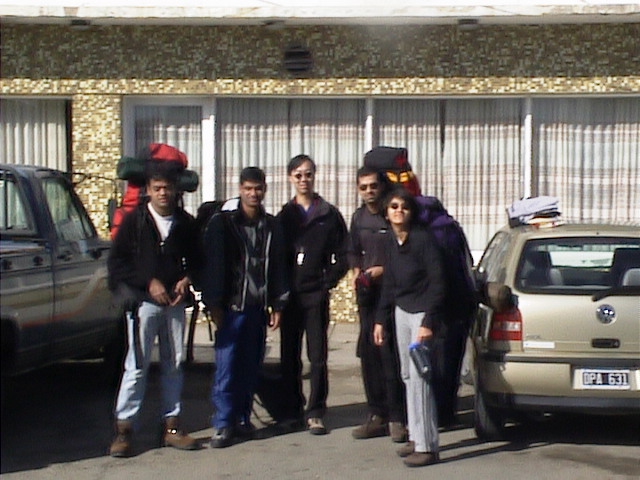
The trip to Torres del Paine, one of the national parks in Chile, is usually made via Santiago, but because we wanted to see Buenos Aires, we flew through there instead. The trip from San Francisco could've been a little more straightforward, as there is a non-stop LA-BA, but we flew SF-LA, LA-BA via Panama. After a quick stop (i.e. overnight) in BA, we then flew down to Rio Gallegos, in southern Argentina, where we had rented a car.
The original plan, since we had read many accounts on the web about not being able to rent a car to go across the border from Argentina into Chile, and which we had heard from Hertz itself from whom we had made a reservation, was to rent the car, drive to Rio Turbio, just on the Argentinia side of the border, and catch a bus to Puerto Natales and from there to the park. As it turned out, when we arrived at Rio Gallegos' small airport, the local Hertz representative was extremely helpful and told us that she could obtain paperwork to allow us to take the car into Chile by the next day. Thus, we overnighted in Rio Gallegos at a small hotel recommended by Lonely Planet, the Ovieto. As long as you don't expect much from hotels in small town Argentina, this wasn't bad. Clean, at least. Here's the group ready to go, in front of the hotel.

The next day, we drove to Puerto Natales, with much of the way on gravel roads. Most of the roads in southern Argentina and Chile are unpaved and we spent many hours on them. The road took us west over gently rolling, but rather desolate landscape. Soon, on the horizon, we could see the southern Andes. The mountains of Torres del Paine, rising to about 6000 ft, are visible from many miles away -- they rise 4000 ft from surrounding lowland quite distinctively, just south of the mountains of Los Glacieres National Park in Argentina. This is our first view of the mountains.
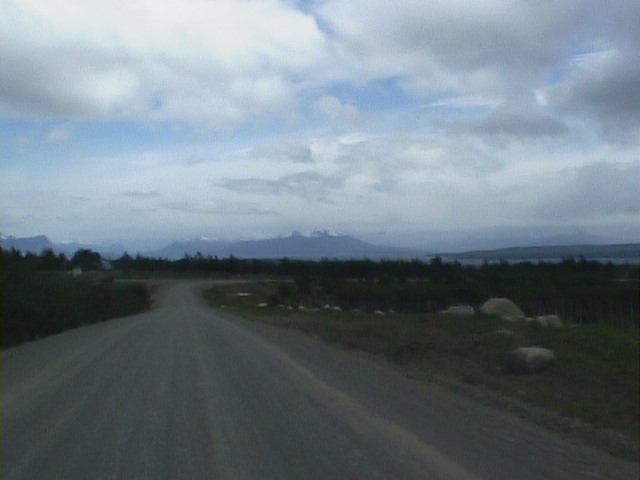
We arrived in Puerto Natales in the late afternoon. At this point south, in late Spring (late Nov), it was light until 9.30pm, and we had some time to wander around town, after finding a room in a funky place called Concepto Indigo, overlooking the harbor. It was pretty chilly, and quite windy, but the view over the harbor was spectacular.

We got an early start the next day, for the two hour drive to the park itself. On the drive, it being early season, there were very few other vehicles. We passed a few buses going the other way, and one guided tour van passed us, but stopped at a waypoint called Cerro Castillo, on the way to the park. We got slightly lost there, but eventually found the right turning (not that there were that many...). About 3/4 of the way to the park, we suddenly could see Torres, and what a sight it was.
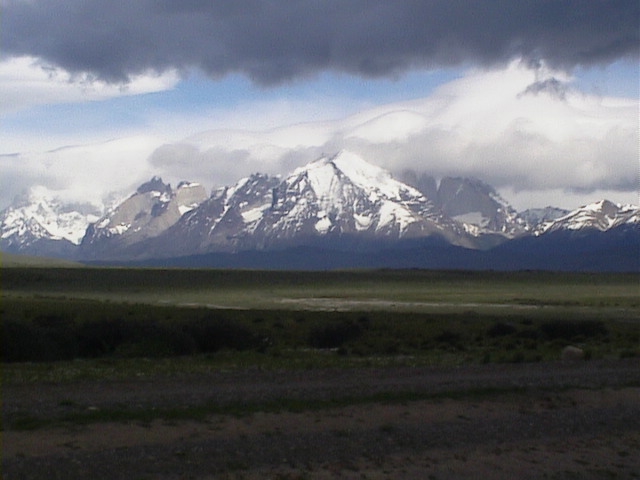
Through a telephoto, this was the best view of the Cuernos we would see
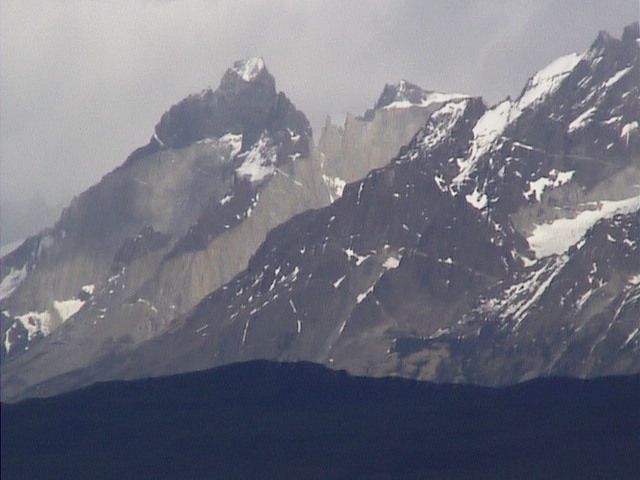
Once we got to the park entrance itself (at Largo Amargo), we paid the entrance fee and figured out what to do. We had had thoughts of doing a car shuttle from the Lago Pehoe ferry stop and Hosteria Las Torres, but decided to leave both cars at the entrance and take the shuttle bus to the Hosteria, where we would begin the hike. Our plans were to hike from the Hosteria up to Refugio Chileno or Campamento Torres, camp, and then walk to Refugio Los Cuernos or Campamento Italiano, depending on how long things took, and the last day, do a day hike up Valle de Frances and then walk to Refugio Pehoe for one last night before taking the ferry across Lago Pehoe to the bus that would take us back to the park entrance and the cars. It was quite reasonably warm at this point, with partly cloudy skies. Probably around 60F, light winds. The shuttle bus ride to the Hosteria is 7 km that some people hike. You don't miss much not hiking it. We used the Hosteria's facilities and filled up with water, and were on our way just after noon.


The hike up to Refugio Chileno is a good climb, and just before the camp, the trail enters the Valle de Ascencio. On our way up, we met several day hikers who were returning from an abortive attempt to get through the initial stretch of the valley. Apparantly, there were really high winds, estimated up to 80 mph, and coupled with a stretch of trail with some exposure, some felt it too dangerous to continue. This news disconcerted one member of the party such that our party of 6 became 4, due to their turning back also. When the remaining hardy 4 got to the valley opening, it had started to rain. This change in the weather also changed the wind so that there was no longer that much wind. And the trail exposure turned out to be really not that bad. After a short while, we came to Campamento Chileno, where we decided to stop for a while, it being only 3pm.
Refugio Chileno is a full service rest stop, with bunks, showers, toilets, cafeteria. We made use of the latter two, had some tea, chatted with folks and played some bridge. Eventually, we decided it was time to press onto Campamento Torres, a 1.5 hr walk. It was raining pretty steadily by this time, though not torrentially, and the hike while starting out pretty level, was mostly uphill, with a couple of small stream crossings. Finally, we reached the clearing before the campsite, and the rain had turned into light snow. The camping area is in a thicket of trees that provides good protection from the elements. We made camp, had our freeze dried dinner and fell asleep to the sound of the wind tearing through the trees.The next day dawned partly cloudy, though we waited until 9am to wake up and see it. It's a short 45 minute hike/boulder scramble up the last part of the trail to the Torres overlook. At the top, it was windy and cold, but what a view!

After stopping long enough to take photos and get cold, we started back down to the campsite, broke camp and started down for Chileno at 11am. Stopped at Chileno for lunch and decided to drop a ton of weight from our packs because (a) we lost two members of the party and (b) we could get food from the Refugio system, so we didn't have to pack so much (and we were packing probably too much food anyway). We paid them $5 to take it off our hands and moved on. The day had become quite a nice day, and we had a bit of wind to battle against down the pass out of the valley. There were a few times we had to pause to let the gust pass, but by and large, it wasn't a big thing. The main trail to Los Cuernos runs from the Hosteria Las Torres, but for those coming down from Chileno, the trail has a signposted shortcut. It says "4 hours to Los Cuernos", and it begins as a well worn path. After not too long, however, the path peters out, and we had to bushwack. Fortunately, we had a map and a general idea of where the main trail ran, and eventually, we saw the trail, which runs along the northern shore of Lago Nordenskald. We joined the trail at a smaller lake and started to get hit with massive blasts of wind. At the edge of the lake, we could see a white wall of spray making its way towards us over the lake, and then it would hit us, and almost knock us over. By seeing the spray line, we could tell when the blasts would come. The wind was whipping up and driving waves over the lake, and carrying the spray in sheets past the end of the lake. It was quite spectacular, and the power of the wind was awesome. I have some videotape of this (357Kb RealVideo). The next picture shows Lago Nordenskald slightly later in the hike, but you can see the white areas of the lake that are being driven by the wind.

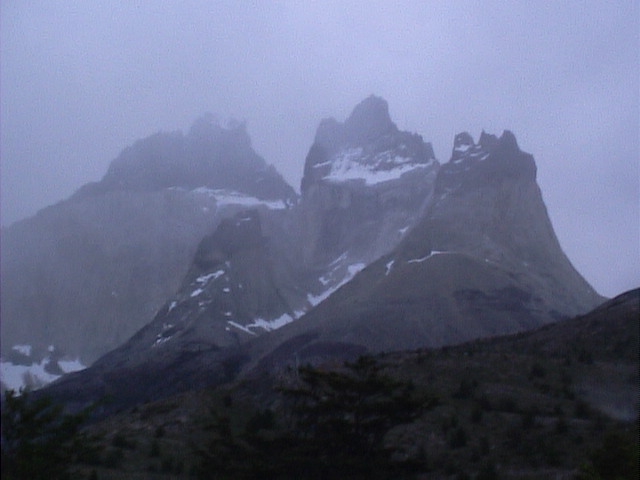
The next day was not nice and sunny. To the contrary, it was rainy, and we slogged for 4 hrs through it from Los Cuernos to Refugio Pehoe, where we planned to stay. If the day had been nicer, i.e. visibility better, we would have done a hike without packs up Valle Frances, from Campamento Italiano, but the clouds were low and we thought that we probably wouldn't be able to see much. Plus, my boots were soaked through. When we got to Pehoe, it turned out that this refugio was run by a different company that Chileno and Los Cuernos, and that because it was in a location readily accessible by anyone, it was full of tour groups. We had a quick cup of tea and got out of there, deciding to take the evening ferry back over Lago Pehoe, a day earlier than planned. It was really kind of wierd suddenly being with such a huge horde of people (probably 50 people), after being pretty much by ourselves for 2 days -- while Chileno was a bit crowded, given that the hike up to the Torres del Paine lookout is done by day hikers, and there were a few people at Los Cuernos -- we had met very few people on the trail itself, so in that sense felt like we had the park to ourselves. This big crowd was a bit of culture shock! I think we were in the park at a good time of the year, before it got too packed.
Upon arriving at the other end of Lago Pehoe, we were surprised to be met by the other 2 members of the group. Turns out that they figured that we might be on this boat and had come to meet us. Such are how plans work out! Before this meeting, we had been wondering how everyone was to meet, since we had no way of real communication, relying only on messages left at the Hosteria Las Torres reception. Fortunately, we did all meet up, and decided against a night in the rain, and drove out of the park. We were initially aiming to return to Puerto Natales, but we weren't too keen on driving the unpaved roads in the dark, so we stopped at Cerro Castillo and stayed at the hosteria there. This hosteria was a large house at the edge of town, and we were the only ones in it. The proprietor was this expressionless (but helpful) guy and we joked that this seemed like a house in a horror movie -- in the middle of nowhere, with a table for 24 all laid out in the dining room! Actually, it was a nice place to stay after a long, wet day.
The plan next was to drive up to the Perito Moreno Glacier and stay in El Calafate, both on the Argentina side. Again, we had many miles of gravel road, and made it to El Calafate by a little after lunchtime. Lunch was followed by a 1.5 hr drive to the glacier, which is one of the few advancing glaciers in the world, moving at up to 2m per day. The glacier is 4 km wide, widening to 6 km at its end.

The glacier is heavily visited (though not the day we were there) and has a well developed overlook area from which you can see the glacier from pretty close. Nevertheless, the size is still not easy to grasp. In the picture below, you can see the railings from which point one is as close as one can get, but it's hard to imagine that what you're seeing is 40-50m of ice face (120-150ft). It just doesn't look that high. While we were there, a big slab calved off the glacier with a big rumble, right in front of us. Quite exciting. Take a look at the video clip (425 Kb RealVideo)
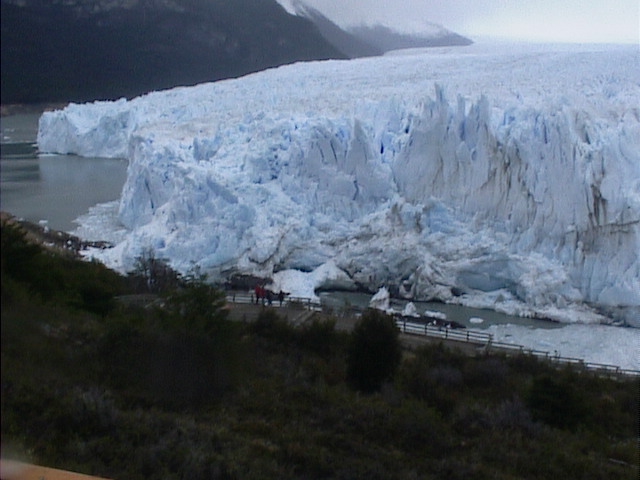
And then it was back to El Calafate for the night, which was spent at another funky place called Casa del Sol, also recommended in Lonely Planet. El Calafate itself is a touristy town with a main street full of souvenir shops. There's a new airport serving the town, opened just a week before we arrived, so it'll be quite the gateway town to Patagonia. This night was our last in Patagonia. The next day, we drove back down to Rio Gallegos to take the flight back to Buenos Aires. Here we are on the LAPA flight.
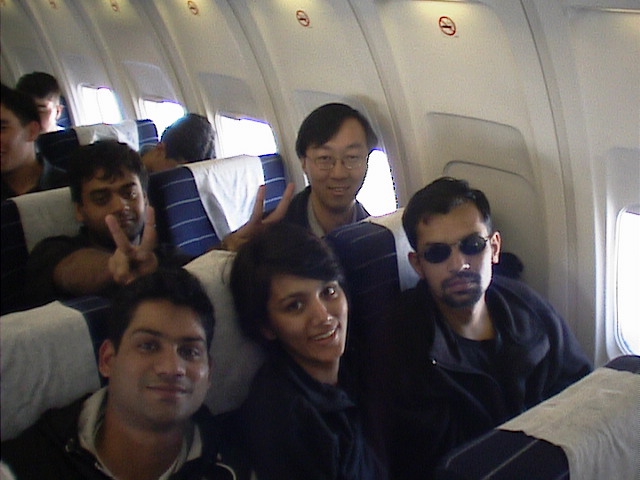
Buenos Aires is quite an interesting city. Huge, and, as everyone says, quite European feeling. Much of that feeling has to do with the fact that the architecture is French influenced and that the population is pretty much 100% caucasian. Food is very meat oriented, with huge slabs offered to you on a plate. Tasty though. We saw some of the main sights, took in some tango, some street fairs, some cafe culture, and used the quite atmospheric subway. This is the Casa Rosada, from which Eva Peron made her famous speech. Interestingly, it's only pink on its facade -- other sides of the building are grey.
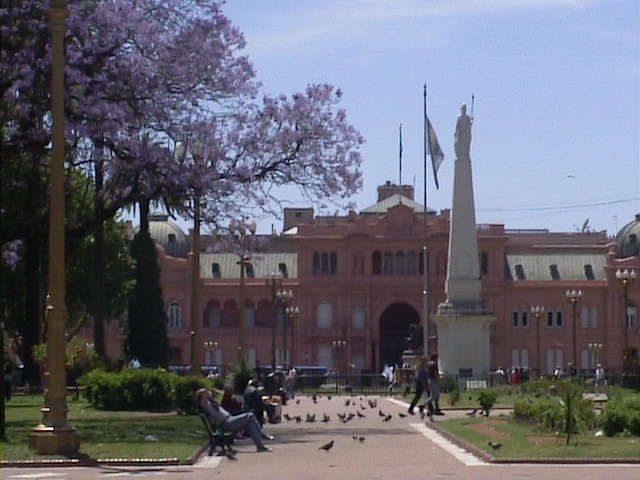
After 10 days -- three days getting to the park, three days in the park, one day seeing the glacier, and two days in Buenos Aires, it was time for us to return home. The flight back was uneventful, with a wonderful sunset on approach to Panama.

The only complication on our return trip was that we were deposited in San Diego instead of LAX, and got bused to LAX, getting us there at 3.30am. From there, we took the early morning shuttle flight to SFO, getting us in at sunrise.
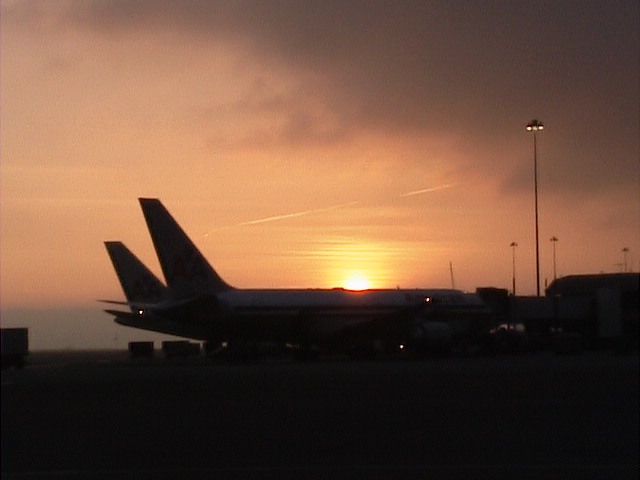
Odds and Ends
The most useful item for the trekking part of the trip were trekking poles. I used a Leki model and I believe that they did wonders for my knees. My theory on how they best help is that they diminish the need for ones knee and hip joints to do the fine balancing required when bipedal. Coupled with that is that one can take the strain off the knees when climbing and descending. Two poles are required.
Gore-tex bootied boots are the only thing that work in continuous rain. I have a pair of La Sportiva M-Kevlar boots, which are partly a kevlar fabric that, despite several layers of Nikwax, proved not waterproof
Mountain House freeze-dried is much tastier, and packaged more conveniently than Richmoor
Other gear -- North Face Mountain Guide jacket: Worked very well. Was able to control temperature very well by means of adjusting main zipper, pit zips, and use of the hood, in various combinations, and it was definitely waterproof without too much sweat induced vapor trapping. Gloves: definitely needed for warmth. Hat: get something that fits under your jacket hood. Anything with a bill doesn't work well with the hood. Some might argue that a brimmed hat is better than a hood, but I don't agree totally. While there is much better visibility and freedom of movement with a separate hat, a hood gives better temperature regulation and wind protection, and the North Face products have very good hood designs. Fleece: I used a jacket from a company called Cloudburst, using wind-blocking fleece. Seemed to work well, and was warm. Down vest: not supposed to bring down on a wet trip, but the one night it was cold, it served me well. The advantages of an expensive down vest over the $19 Old Navy specials are in the little things: elasticated arm openings and bottom to keep heat inside. Of course, better down. Sleeping bag: I'm a cold sleeper, and the coldest night was probably in the mid 20s F. I used a 5 degree Western Mountaineering bag that was nice and toasty. Tent: mindful of the wind and rain potential, I brought a 4-season tent, the Walrus Hurricane Hole. A bit fiddly to set up, but has one major advantage: the fly is set up first and the inner tent set up inside, so if it's really raining, the inner tent doesn't get wet. Also, it's a stable design. The other party had a $99 special and during the night, were worried that it would get blown away, with them inside it! Fortunately for them, it didn't rain much through the night, and they didn't get blown away.
If you enjoyed this travelogue, or have any questions, let me know!